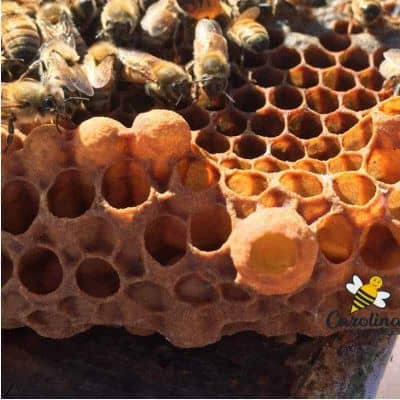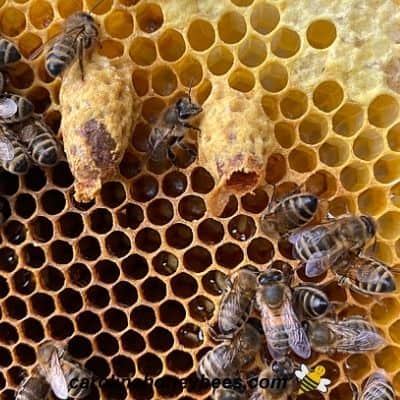What to do With Queen Cells?
When a recent hive inspection reveals one or more large peanut-shaped wax structures, the new beekeeper may not understand. But, those of us with a bit of experience recognize reproductive queen cells when we see them. The difficult question is – what to do with queen cells found in your hive? Unfortunately, the answer is not always simple – it depends on many factors. Let’s dive in and explore the options.

We know the importance of having a good queen in residence in the hive. This is why her status is such a big part of beehive management. Sometimes the beekeeper needs to intervene to help the colony stay productive. And yes, sometimes we need to leave them alone and just let them be bees!
Finding Queen Cells in the Hive – Now What?
Your decision of what to do with any queen cell is based on the needs of the colony and your goals for the hive.
When we find anything “unusual to us” in the hive, it is common to think – now what are these bees doing? While honey bees always have a plan – it is not necessarily always in their best interest.
Learning when to do something and when not – that is the skill of beekeeping. There are many variables involved in managing bees-no two hives are the same.

Assessment of Reproductive Cells
Most of the time, it is relatively easy to identify queen cells. As a larger (longer) member of the colony naturally she need a bigger wax cell for development.
Even though the size of a queen bee varies (even in maturity), she can not develop to her adult size in ordinary brood cells.
Before you can decide what to do with queen cells in your hive, you should attempt to discover why the bees are building them.
- type of queen cell
- quantity and positioning
- size and texture
Identify the Type of Queen Cell
The actual cells themselves are alike but the reasons for building them are different. Each one tells a story about what is happening inside the hive. This affects what your actions should be.
3 Reasons for Cell Development
- emergency cells – occurs when queen bee dies unexpectedly
- supersedure cell – replacement for failing queen – poor egg laying or low bee pheromones
- swarm cells – colony is rearing new queens and preparing to swarm
Quantity and Positioning
While it is not always a “set in stone” rule, the number and placement of queen cells can tell you something about the hive’s intentions. In general:
- emergency cells – are scattered anywhere on the comb where young larva are found
- supersedure cells – are found within the brood nest (often in small groups)
- swarm cells – many cells often found along the bottom of frames

Check Hive History and Status
Before doing anything, you need to reflect on the recent history of the colony. Check your hive records to discover any recent problems or stresses the bees may have experienced.
Do a thorough beehive inspection to evaluate the condition of the hive overall. Can you find the queen bee? Also, check the colony brood pattern for a uniform pattern of worker brood (or not).
It is also a good idea to just listen for a minute. If a new virgin has emerged from a cell, you may hear queen piping sounds.
When to Intervene
Deciding when to intervene and when to let nature take its course is one of the hardest parts of beekeeping – at least for me. Sometimes, doing nothing is best. Other times – doing nothing means a dead hive in a few weeks.
Factors Affecting Your Decision
- time of year – not every month is a good time to split a colony
- colony strength – does the colony have enough workers to maintain itself
- overcrowding in the hive – split or let them swarm
Beekeeper Options
When making a decision about what to do with queen cells in your hive, we certainly have a lot of factors to consider. But, they are there and even if you never know exactly why-you can base your actions on your best guesses.
What to do with Supersedure Cells
Cells higher up on the face of the frames are likely supersedure queen cells – especially if the queen bee is still present and some worker brood is seen.
Do Nothing – Trust the Bees
In most cases, trust the bees and let them replace her if they want to. Letting the bees rear a new queen does introduce local genetics into the hive.
However, you run the risk of an inferior queen being produced. Or even, her being eaten by a bird on her mating flight.
Check back in a couple of weeks to insure that replacement was successful and the colony has fresh brood.

Emergency Cell Options
Sometimes, supersedure cells and emergency cells are hard to tell apart. Finding just a couple scattered here and there on the comb may indicate that the colony in in crisis.
If the cells are very small or seem or poor quality, this is not good. They are working with what they have but may not have the best larvae to work with. Giving them a mated queen is a good choice because they will have new worker bees sooner.
Consider Ordering a Queen
If you want to try new genetics, this is a good time to buy a new queen for the hive. Tear down any queen cells and kill the old queen before introducing a new one.
But, wait until you have the new queen in your hand. If the new queen doesn’t arrive on time, you may be worried. You can keep her in the queen cage for a few days.
Use Extra Queens for New Colonies
If you have enough bee population to work with or several hives, there are several ways to use extra queen cells.
Splitting the Colony
Splitting a large strong hive into smaller parts is one way to manage overcrowding and slow down the natural swarm impulse. The resources of the large colony is divided into 2 parts.
If you do not want more hives long term, you may be able to combine hives later in the season – once the time of heavy swarming is over.
This is another reason it is a good idea to always keep extra beekeeping equipment on hand.
Start a Nuc Hive
Beekeepers buy smaller colonies called nucs and install them to create a new colony. Excess queen cells can also be used to start a small nuc colony.
If colony A is strong with many replacement cells and a laying queen, you can move the frame with some of the queen cells (or the old queen herself) to a new box.
Then, add a few frames of bees (from that hive), brood, honey and pollen from the mother hive or others in the bee yard. Let this new split raise a new queen bee.
If you have a very large colony, you may even split it into 3 smaller hives. But don’t “spread your bees too thin”, or you will end up with several weak colonies.
Be aware if you take too many resources from your main colonies, you may miss the honey flow for the season.
As I tell students in my Online Beekeeping Class, being a good beekeeper is about balance – you have to work with the natural tendencies of the honey bee.
Help a Queenless Colony
Seeing queen cells in the hive can be a good thing. Sometimes a beekeeper is delighted to find them. If needed, you can use these extra cells to help another colony.
A queen cell can be given to a colony without a queen. This gives them a jump start as they do not have to construct a cell from scratch.
Give the queenless colony plenty of worker bees, honey and a queen cell. In a couple of weeks, you may have a young, laying queen.

What to do About Queen Cups
You may find some small acorn shaped wax structures on the comb. We call this a “queen cup”. It is normal for a colony to have some cups in place – even when not needed. If fact, many of them are never used.
And, some colonies just build more than others – its a genetic thing. Certain types of honey bees (races) keep more on hand – a bit of pre-preparation “just in case”.

Don’t be alarmed when you see a few cups during hive inspections. But, if you see many newly constructed cups in a hive that didn’t previously have them – take heed.
Something may be brewing in the colony. Once you see an egg or larva in a cup – the race is on – your colony is making a new queen.
Should I Destroy Queen Cells?
Do not destroy queen cells you find in your hive. You can always cut out cells later but you can’t put them back once they are destroyed.
When deciding what to do with queen cells, you can avoid waste and big mistakes with your colony by trying to understand the reason behind cell construction.
Many cells often indicate swarm preparations. However, cutting out all the queen cells does not stop the swarming impulse. The process is just delayed. Your bees will just build more.
Try to understand what the bees are telling you. Is the hive crowded with bees? Is the queen in the hive older, etc.?
FAQs
Bees have a miraculous system for making a new queen. However, it is fraught with risk and the colony has only a limited amount of time to get the job done. Multiple cells increase the chance of success.
If you find a queen cell that is open on the end, you likely have an emerged queen. However, she may not be mated and laying yet. If you do not see fresh brood, carefully close the hive and check again in 7-10 days. 
Yes, you can cut out the swarm cells – as long as you know the old queen is still present. However, this is only a stopgap measure and is labor intensive.
If you miss even 1 cell, the colony can still swarm. This is why most beekeepers put swarm prevention techniques into practice early in the season.
It is common for beekeepers to remove some of the queen cells when a lot are present. A good average is to leave 2-3 nice large cells.
When seeing swarm cells that you don’t want to use, you can try cutting them out a couple of times and hope the bees change their mind. However, they will likely swarm anyway. Be sure to check later to make sure they have a new queen.
No, there is no need to remove queen cups. Until they have an egg or larva, they are just placeholders.
Final Thoughts
Discovering that your colony is building reproductive cells is certainly a reason for excitement. However, it is important to take the time to consider what it means before you take action. If the colony feels a need to replace the queen, maybe you should let them.
Does it look like a swarm is on the way? Put out your swarm traps. Or you can use queen cells to help grow your apiary. This is a sustainable process-as long as you do not get more hives that you can manage.

